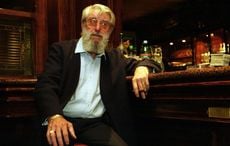I had one encounter with Margaret Thatcher, which will long live in my memory.
She died on Monday at age 87.
It was in Texas around 1984, at a press conference when she was on a U.S. visit.
At the time there was a huge controversy about American weapons being supplied to the RUC, the very sectarian Northern police force that was conducting a shoot-to-kill policy in many areas and was clearly colluding with Loyalist killers, as the Patrick Finucane murder clearly showed.
In the midst of a crowded news conference on U.S.-British relations, Thatcher’s press secretary unexpectedly pointed at me for the next question.
I asked her about the RUC and its reputation and whether she condoned its activity on shoot-to-kill activities. Then I sat down.
There was a moment of quiet.
Then suddenly I heard her stentorian tones.
“Stand up!” she demanded. “Stand up and explain what you mean.”
Suddenly every one in the room was staring at me, and I felt the full power of the Iron Lady's piercing stare.
She was, of course, upset that the trivial matter of police collusion and American weapons for the RUC was coming up at a press conference on world matters. Her response was to ridicule the question and also the questioner.
I’m sure her press secretary later got a bollicking for calling on an Irish ingrate for a question.
I got a brief sense of how dreadful it must have been to be in her cross-hairs and how effective she was as a bully and a no-holds barred politician.
No wonder she intimidated every member of her cabinet, eventually alienating them. Not surprisingly she also had the media fawning over her, even when she praised South Africa, supported the Chilean junta and the Khmer Rouge among others.
During her three terms as prime minister, Irish America -- on issues such as guns for the RUC and the Finucane murder -- was one of the few constraining forces on her Northern Ireland policy.
There are many, myself included, who believe that Thatcher herself may have ordered the Finucane killing. Finucane, remember, was referred in the British Parliament under privilege by one of Thatcher’s ministers as an IRA-defending lawyer.
She clearly disliked the Irish and especially the whole notion of Northern Ireland being less British than Finchley. Even Ronald Reagan, her bosom buddy, tried at times to temper her hard line on the North, but not to much effect.
On the deaths of the 10 hunger strikers in 1981, which she could easily have avoided, she struck a new and dreadful note of intransigence in Anglo-Irish relationships.
The IRA tried to kill her on the eve of the Tory conference in Brighton in 1986, which undoubtedly led to even more vitriol on her side -- understandable in those circumstances.
Yet as Sinn Fein leader Gerry Adams pointed out, despite her hard line she authorized secret contacts with the IRA at the height of The Troubles, and clearly indicated by allowing those contacts that the status quo was inoperable.
However, she could never admit as much to herself or publicly, and it took one of her successors, Tony Blair, to make history and help create the conditions for an historic compromise.
Thatcher may be hailed in many world capitals this week, but not in most of Dublin or Belfast I suspect, or by Irish Nationalists anywhere on the globe. Her anti-Irish streak was just too plain for all of us to see.




Comments